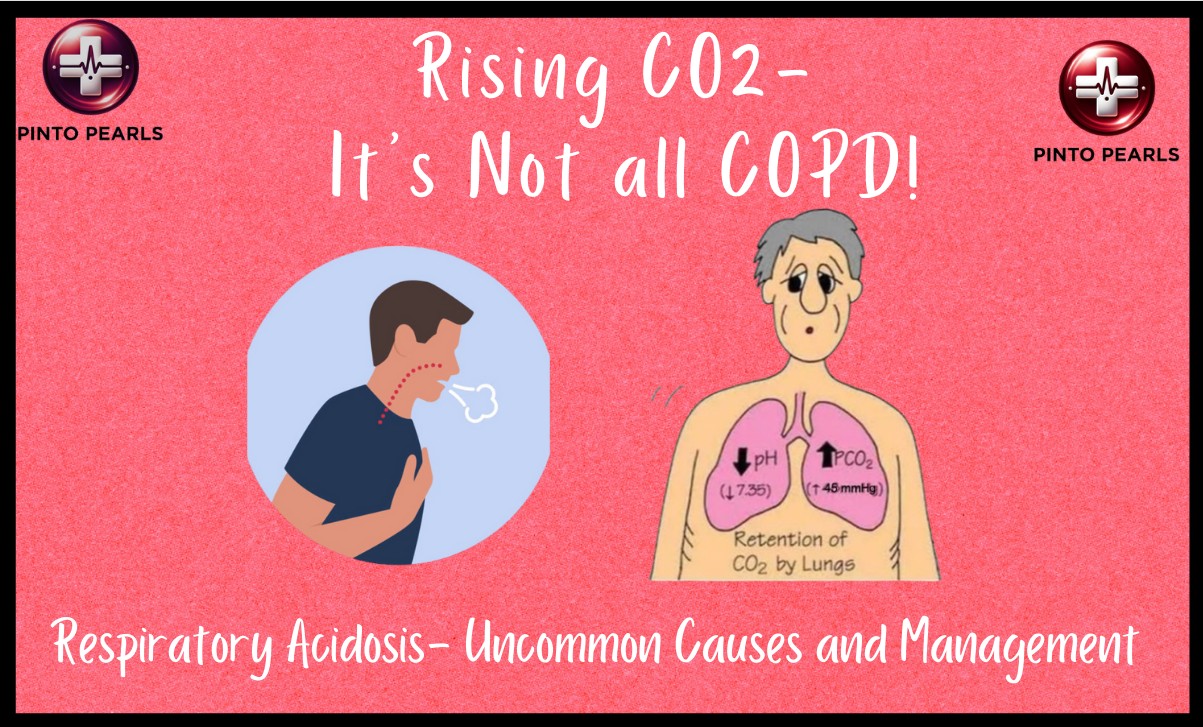

Hey all
Today we are getting into the nitty gritty!
Elevated pCO2 (hypercapnia) often points to respiratory failure, and is often caused by COPD.
However, there can be multiple other causes for it, and the management can be much more complex.
Let’s explore four cases where pCO2 is elevated and see if you can determine the diagnosis and next steps!
Case #1:
A 32-year-old male known opioid user is found unresponsive at home, with shallow breathing and pinpoint pupils. He is given naloxone en route to the ED with some improvement in mental status. His VBG shows: pH 7.22, pCO₂ 72 mmHg, HCO₃ 20 mEq/L. Despite regaining some consciousness, he appears lethargic and has coarse crackles on auscultation.
What do you think is happening? What are your next steps?
Case #2:
A 56-year-old woman (BMI 52 kg/m²) presents with progressive shortness of breath, daytime sleepiness, and morning headaches. Family reports increasing confusion and lethargy over two days. She denies fever or cough but has a history of loud snoring and gasping during sleep. On examination she is obese, somnolent but arousable, diminished breath sounds, mild leg edema with normal vitals. Her VBG shows: pH 7.30, pCO₂ 65 mmHg, HCO₃ 34 mEq/L, and has a normal CXR.
What do you think is happening? What are your next steps?
Case #3:
A 28-year-old woman presents with progressive dyspnea and difficulty clearing secretions over the past several weeks. She mentions increasing fatigue, intermittent difficulty swallowing, and double vision, especially later in the day. She denies fever or recent illness. On exam, she has nasal speech, a weak cough, and fatigable limb weakness. VBG reveals: pH 7.31 pCO2 of 58 mmHg and a HCO₃⁻ 30 mEq/L
What do you think is happening? What are your next steps?
Case #4:
A 68-year-old male presents to the emergency department with worsening dyspnea, increased productive cough, and yellowish sputum. He appears cyanotic and is using accessory muscles to breathe. His vital signs are notable for tachypnea, and VBG results show a pH of 7.25, pCO2 of 60 mmHg and HCO3- 24 mEq/L
What do you think is happening? What are your next steps?
….
Answer:
Recall that pCO2 refers to the amount of CO2 gas in the blood.
It’s an important measure used to assess a person’s respiratory function and overall acid-base balance. The normal range for pCO2 in arterial blood is typically between 35-45 mmHg
When the pCO2 level is high (hypercapnia), it means there is an excess of CO2 in the blood. This condition can be caused by several factors and has different implications depending on the context:
Possible Causes of High pCO2 (Hypercapnia):

Clinical Significance of High pCO2:

Conditions that Cause Respiratory Acidosis- PCO2 Elevations
Ok, let’s go back to the cases,
Case #1:
Diagnosis: Opioid overdose complicated by aspiration pneumonia.
-
While opioid toxicity was the trigger, his persistent drowsiness after naloxone, and crackles suggest something more.
-
CXR revealed a right lower lobe infiltrate
Management:
-
IV antibiotics.
- Airway protection
- Persistent hypercapnia despite naloxone and ongoing drowsiness warrants intubation over non-invasive ventilation (NIV).
- Admission to hospital
Case #2:
Diagnosis: Obesity Hypoventilation Syndrome (OHS) with acute-on-chronic respiratory failure
-
Her chronic hypercapnia (Elevated HCO3) and obesitypoint to Obesity Hypoventilation Syndrome (OHS), which has now tipped intoacute-on-chronic respiratory failure.
Management:
-
BiPAP (IPAP 12, EPAP 6 cm H₂O) → Helps Improve mental status, reduces dyspnea
-
Low-flow oxygen (1-2 L/min) Prevents worsening CO₂ retention.
-
Diuretics (if signs of fluid overload)
-
Referral for sleep study, weight loss interventions
Case #3:
Diagnosis: Myasthenia crisis with diaphragm involvement
-
Her neuromuscular symptoms—especially bulbar involvement and progressive weakness—suggest an underlying disorder affecting respiratory muscles.
-
This could cause hypoventilation/ impending respiratory failure.
Management:
-
Admitted to the ICUfor close observation and worsening respiratory function
-
IVIG treatment
-
Avoid High-flow oxygen to prevent worsening hypoventilation.
-
Non-invasive ventilation initially, but intubation is ultimately required if respiratory fatigue worsens
-
Steroid-sparing agents upon recovery to prevent future crises.
Case #4:
Diagnosis: acute exacerbation of COPD,
-
Chronic airway obstruction and inflammation impair ability of the lungs to expel CO2 efficiently
Management
-
Controlled oxygen therapy → Target SpO₂ 88-92% to prevent worsening CO₂ retention.
-
Bronchodilators: Inhaled beta-agonists (e.g., albuterol) and anticholinergics (e.g., ipratropium) to relieve bronchospasm and improve airflow.
-
Systemic corticosteroids: Prednisone or methylprednisolone can reduce inflammation and decrease airway resistance.
-
Non-invasive ventilation (NIV): BiPAP to improve ventilation, reduce CO2 retention, and support the patient’s respiratory efforts.
Take-Home Points:
Hypercapnia is more than just “hypoventilation.” Recognizing the underlying cause is critical to targeted management.
-
Hypercapnia isn’t always just opioids or COPD. Consider metabolic, neuromuscular, and endocrine causes.
-
Look for compensatory patterns. Chronic CO₂ retention should have a high HCO₃⁻; an acute process shouldn’t.
-
Neuromuscular causes are sneaky. If there’s weakness, assess pulmonary function beyond just ABGs.
-
Obesity Hypoventilation Syndrome and severe OSA are often missed in obese patients. Many cases are only caught when respiratory failure occurs..
-
Opioid toxicity can mask underlying pneumonia, requiring a multimodal approach.
-
BiPAP is a game-changer. Recognizing early signs of CO₂ retention prevents intubation, BUT in some cases Intubation is unavoidable

